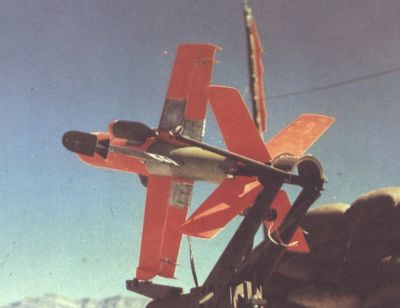Aerophysics Development SSM-A-23 Dart
In 1951, the U.S. Army issued a requirement for an anti-tank guided missile, and in November 1951, the Aerophysics Development Corp. (a subsidiary of Curtiss-Wright) submitted a design proposal for the Dart wire-guided anti-armour missile. After a feasibility study, and a preliminary evaluation of the French SS.10 missile then in development, Aerophysics received a development contract for the SSM-A-23 Dart in April 1953. The first launch of an XSSM-A-23 prototype occurred in August 1954, followed by about 40 more in the next 12 months.
 |
| Photo: U.S. Army |
| XSSM-A-23 |
The XSSM-A-23 was powered by a Grand Central dual-thrust solid-propellant rocket motor, and was fired from an M59 truck-mounted launcher. After launch, the Dart's bright tail-mounted sodium flare was optically tracked by the operator, who would send corrective commands via a spooled-out wire to keep the missile on the line of sight to the target. The Dart had comparatively large cruciform wings and fins for stabilization and control, and used wingtip spoilers for steering. It's maximum range was about 3000 m (10000 ft), and to increase accuracy for long-range shots, an infrared terminal homing device was to be installed. The missile's anti-armour warhead detonated on impact.
 |
| Photo: U.S. Army |
| XSSM-A-23 |
The development of the Dart turned out to be much more difficult and expensive than originally expected, and in late 1956 the system was still far from ready for deployment. In fact, Aerophysics was blamed for having grossly underestimated the complexity of the task. In 1957, it was decided to stretch out the development schedule and reduce the requirements, but in September 1958, the Dart program was finally cancelled. By then, the French SS.10 missile was fully developed, and was eventually adopted by the U.S. Army as an interim anti-tank missile system. The SS.10 was not only simpler and more reliable than the SSM-A-23, but its more compact size also made it easier to handle and deploy in the field.
Specifications
Note: Data given by several sources show slight variations. Figures given below may therefore be inaccurate!
Data for XSSM-A-23:
| Length | 1.52 m (5 ft) |
| Wingspan | 1.02 m (3 ft 4 in) |
| Diameter | 20.3 cm (8 in) |
| Weight | 45 kg (100 lb) |
| Speed | 965 km/h (600 mph) |
| Range | 3000 m (10000 ft) |
| Propulsion | Grand Central dual-thrust solid-fueled rocket |
| Warhead | Shaped charge anti-armour |
Main Sources
[1] Bill Gunston: "The Illustrated Encyclopedia of Rockets and Missiles", Salamander Books Ltd, 1979
[2] Frederick I. Ordway III, Ronald C. Wakeford: "International Missile and Spacecraft Guide", McGraw-Hill, 1960
[3] Redstone Arsenal Historical Information Website
Back to Directory of U.S. Military Rockets and Missiles, Appendix 1
Last Updated: 2 February 2003